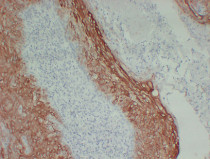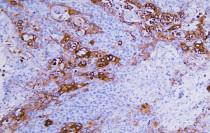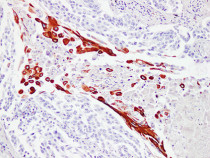ARG66491
anti-Cytokeratin 16 antibody
anti-Cytokeratin 16 antibody for IHC-Formalin-fixed paraffin-embedded sections and Human
Overview
| Product Description | Mouse Monoclonal antibody recognizes Cytokeratin 16 |
|---|---|
| Tested Reactivity | Hu |
| Tested Application | IHC-P |
| Host | Mouse |
| Clonality | Monoclonal |
| Isotype | IgG |
| Target Name | Cytokeratin 16 |
| Antigen Species | Human |
| Immunogen | Synthetic peptide derived from Human Cytokeratin 16. |
| Conjugation | Un-conjugated |
| Alternate Names | KRT16A; K16; FNEPPK; Cytokeratin-16; PC1; K1CP; Keratin-16; CK-16; CK16; NEPPK; Keratin, type I cytoskeletal 16 |
Application Instructions
| Application Suggestion |
|
||||
|---|---|---|---|---|---|
| Application Note | IHC-P: Antigen Retrieval: Citric acid buffer (pH 6.0) was used. * The dilutions indicate recommended starting dilutions and the optimal dilutions or concentrations should be determined by the scientist. |
Properties
| Form | Liquid |
|---|---|
| Purification | Affinity purification with immunogen. |
| Buffer | PBS, 0.02% Sodium azide, 50% Glycerol and 0.5% BSA. |
| Preservative | 0.02% Sodium azide |
| Stabilizer | 50% Glycerol and 0.5% BSA |
| Concentration | 1 mg/ml |
| Storage Instruction | For continuous use, store undiluted antibody at 2-8°C for up to a week. For long-term storage, aliquot and store at -20°C. Storage in frost free freezers is not recommended. Avoid repeated freeze/thaw cycles. Suggest spin the vial prior to opening. The antibody solution should be gently mixed before use. |
| Note | For laboratory research only, not for drug, diagnostic or other use. |
Bioinformation
| Database Links | |
|---|---|
| Gene Symbol | KRT16 |
| Gene Full Name | keratin 16, type I |
| Background | The protein encoded by this gene is a member of the keratin gene family. The keratins are intermediate filament proteins responsible for the structural integrity of epithelial cells and are subdivided into cytokeratins and hair keratins. Most of the type I cytokeratins consist of acidic proteins which are arranged in pairs of heterotypic keratin chains and are clustered in a region of chromosome 17q12-q21. This keratin has been coexpressed with keratin 14 in a number of epithelial tissues, including esophagus, tongue, and hair follicles. Mutations in this gene are associated with type 1 pachyonychia congenita, non-epidermolytic palmoplantar keratoderma and unilateral palmoplantar verrucous nevus. [provided by RefSeq, Jul 2008] |
| Function | Epidermis-specific type I keratin that plays a key role in skin. Acts as a regulator of innate immunity in response to skin barrier breach: required for some inflammatory checkpoint for the skin barrier maintenance. [UniProt] |
| Calculated MW | 51 kDa |
Images (4) Click the Picture to Zoom In
-
ARG66491 anti-Cytokeratin 16 antibody IHC-P image
Immunohistochemistry: Paraffin-embedded Human cutaneous squamous cell carcinoma stained with ARG66491 anti-Cytokeratin 16 antibody at 1:200 (4°C, overnight). Antigen Retrieval: Citric acid buffer (pH 6.0) was used.
-
ARG66491 anti-Cytokeratin 16 antibody IHC-P image
Immunohistochemistry: Paraffin-embedded Human esophageal squamous carcinoma stained with ARG66491 anti-Cytokeratin 16 antibody at 1:200 (4°C, overnight). Antigen Retrieval: Citric acid buffer (pH 6.0) was used.
-
ARG66491 anti-Cytokeratin 16 antibody IHC-P image
Immunohistochemistry: Paraffin-embedded Human squamous cell lung carcinoma stained with ARG66491 anti-Cytokeratin 16 antibody at 1:200 (4°C, overnight). Antigen Retrieval: Citric acid buffer (pH 6.0) was used.
-
ARG66491 anti-Cytokeratin 16 antibody IHC-P image
Immunohistochemistry: Paraffin-embedded Human tonsil stained with ARG66491 anti-Cytokeratin 16 antibody at 1:200 (4°C, overnight). Antigen Retrieval: Citric acid buffer (pH 6.0) was used.









